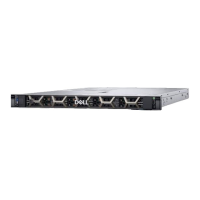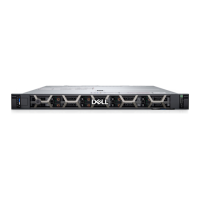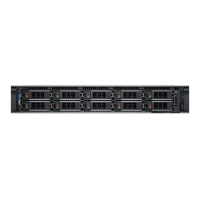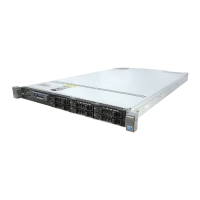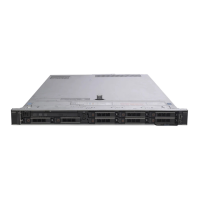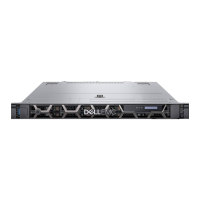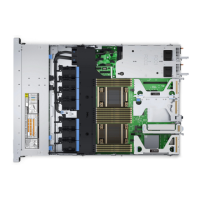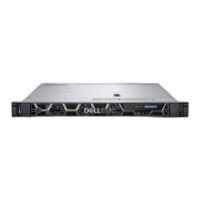Do you have a question about the Dell PowerEdge R660xs and is the answer not in the manual?
Describes the front panel components, ports, and indicators of the system.
Details the indicators and buttons on the left control panel of the system.
Describes the power button, USB port, and iDRAC Direct port on the right control panel.
Identifies the ports, panels, and slots on the rear of the system.
Provides an overview of the internal components and their locations within the system.
Describes the location and content of the system information label.
Explains how to find the system's unique service identifiers.
Provides information on rail compatibility and sizing for rack installation.
Details the physical dimensions of the system chassis.
Provides information on the system's weight and handling recommendations.
Lists the supported processors and their configurations for the system.
Details the specifications for the Power Supply Units (PSUs) supported by the system.
Lists the operating systems that are compatible with the PowerEdge R660xs system.
Describes the types and specifications of cooling fans used in the system.
Specifies the type of system battery used in the PowerEdge R660xs.
Details the specifications for expansion card slots and risers.
Lists the memory module types, capacities, and speed supported by the system.
Details the supported storage controller cards for the system.
Outlines the types and quantities of drives supported by the system.
Describes the specifications for various ports and connectors on the system.
Details the supported video resolutions and graphics controller.
Provides operating environment specifications and conditions for the system.
Outlines the basic steps required to set up the server.
Explains how to configure the Integrated Dell Remote Access Controller (iDRAC).
Lists resources and methods for installing an operating system on the system.
Provides options and documentation links for downloading system drivers and firmware.
Lists the essential components required for the system to POST.
Explains how system configuration is validated and errors are reported.
Outlines essential safety precautions to follow before working on the system.
Lists the tools required for component removal and installation procedures.
Describes how to remove and install the optional front bezel.
Details the procedure for removing and installing the system cover.
Explains how to remove and install the drive backplane cover.
Provides instructions for removing and installing the air shroud for cooling.
Describes how to remove and install the system cooling fans.
Details the removal and installation of the intrusion switch module.
Covers the removal and installation of drive blanks, carriers, and drives.
Describes the supported drive backplanes and procedures for removal/installation.
Illustrates cable routing configurations for various system components.
Provides guidelines and procedures for installing and removing system memory modules.
Details the removal and installation of the processor and heat sink module.
Explains expansion card installation guidelines and riser configurations.
Covers the removal and installation of the 2.5-inch rear drive cage.
Describes the removal and installation of the optional serial COM port.
Details the removal and installation of M.2 BOSS risers and cards.
Provides procedures for removing and installing the optional OCP card.
Describes how to remove and install the front mounting front PERC module.
Details the removal and installation of the rear mounting front PERC module.
Covers the replacement procedure for the system battery.
Describes the removal and installation of the optional internal USB card.
Provides instructions for removing and installing the VGA module.
Details the removal and installation of power supply units and blanks.
Covers the removal and installation of the power interposer board.
Provides procedures for removing and installing the system board.
Details the removal, installation, and initialization of the TPM.
Covers the removal and installation of the right and left control panels.
Describes the system status LED indicators and their conditions.
Explains the system health and system ID indicator codes.
Details the indicator codes for the iDRAC Quick Sync 2 feature.
Describes the indicator codes for the iDRAC Direct LED.
Explains the LCD panel features, navigation, and status indicators.
Provides information on NIC indicator codes for link and activity status.
Details the indicator codes for AC and DC Power Supply Units (PSUs).
Explains the drive indicator codes on the drive carrier.
Guides on how to run system diagnostics for hardware testing.
Identifies and describes the connectors on the system board.
Details the system board jumper settings and their functions.
Explains how to disable system and setup passwords using jumpers.
Information on product disposal and recycling services.
Details on how to contact Dell for support and service options.
Explains how to use the Quick Resource Locator (QRL) for system information.
Describes the benefits of using Secure Connect Gateway for automated support.
Provides links to other relevant documents and resources.
Describes the front panel components, ports, and indicators of the system.
Details the indicators and buttons on the left control panel of the system.
Describes the power button, USB port, and iDRAC Direct port on the right control panel.
Identifies the ports, panels, and slots on the rear of the system.
Provides an overview of the internal components and their locations within the system.
Describes the location and content of the system information label.
Explains how to find the system's unique service identifiers.
Provides information on rail compatibility and sizing for rack installation.
Details the physical dimensions of the system chassis.
Provides information on the system's weight and handling recommendations.
Lists the supported processors and their configurations for the system.
Details the specifications for the Power Supply Units (PSUs) supported by the system.
Lists the operating systems that are compatible with the PowerEdge R660xs system.
Describes the types and specifications of cooling fans used in the system.
Specifies the type of system battery used in the PowerEdge R660xs.
Details the specifications for expansion card slots and risers.
Lists the memory module types, capacities, and speed supported by the system.
Details the supported storage controller cards for the system.
Outlines the types and quantities of drives supported by the system.
Describes the specifications for various ports and connectors on the system.
Details the supported video resolutions and graphics controller.
Provides operating environment specifications and conditions for the system.
Outlines the basic steps required to set up the server.
Explains how to configure the Integrated Dell Remote Access Controller (iDRAC).
Lists resources and methods for installing an operating system on the system.
Provides options and documentation links for downloading system drivers and firmware.
Lists the essential components required for the system to POST.
Explains how system configuration is validated and errors are reported.
Outlines essential safety precautions to follow before working on the system.
Lists the tools required for component removal and installation procedures.
Describes how to remove and install the optional front bezel.
Details the procedure for removing and installing the system cover.
Explains how to remove and install the drive backplane cover.
Provides instructions for removing and installing the air shroud for cooling.
Describes how to remove and install the system cooling fans.
Details the removal and installation of the intrusion switch module.
Covers the removal and installation of drive blanks, carriers, and drives.
Describes the supported drive backplanes and procedures for removal/installation.
Illustrates cable routing configurations for various system components.
Provides guidelines and procedures for installing and removing system memory modules.
Details the removal and installation of the processor and heat sink module.
Explains expansion card installation guidelines and riser configurations.
Covers the removal and installation of the 2.5-inch rear drive cage.
Describes the removal and installation of the optional serial COM port.
Details the removal and installation of M.2 BOSS risers and cards.
Provides procedures for removing and installing the optional OCP card.
Describes how to remove and install the front mounting front PERC module.
Details the removal and installation of the rear mounting front PERC module.
Covers the replacement procedure for the system battery.
Describes the removal and installation of the optional internal USB card.
Provides instructions for removing and installing the VGA module.
Details the removal and installation of power supply units and blanks.
Covers the removal and installation of the power interposer board.
Provides procedures for removing and installing the system board.
Details the removal, installation, and initialization of the TPM.
Covers the removal and installation of the right and left control panels.
Describes the system status LED indicators and their conditions.
Explains the system health and system ID indicator codes.
Details the indicator codes for the iDRAC Quick Sync 2 feature.
Describes the indicator codes for the iDRAC Direct LED.
Explains the LCD panel features, navigation, and status indicators.
Provides information on NIC indicator codes for link and activity status.
Details the indicator codes for AC and DC Power Supply Units (PSUs).
Explains the drive indicator codes on the drive carrier.
Guides on how to run system diagnostics for hardware testing.
Identifies and describes the connectors on the system board.
Details the system board jumper settings and their functions.
Explains how to disable system and setup passwords using jumpers.
Information on product disposal and recycling services.
Details on how to contact Dell for support and service options.
Explains how to use the Quick Resource Locator (QRL) for system information.
Describes the benefits of using Secure Connect Gateway for automated support.
Provides links to other relevant documents and resources.

